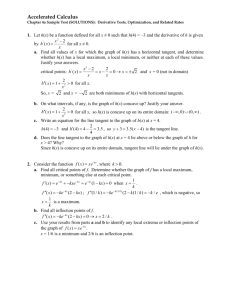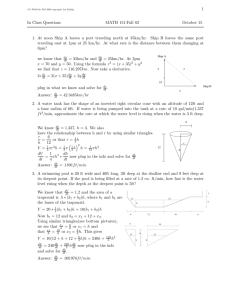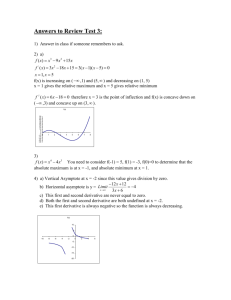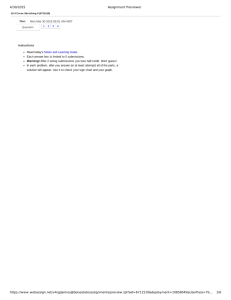Solution: APPM 1350 Exam 1 Spring 2014 1. (5 points each) Find
advertisement
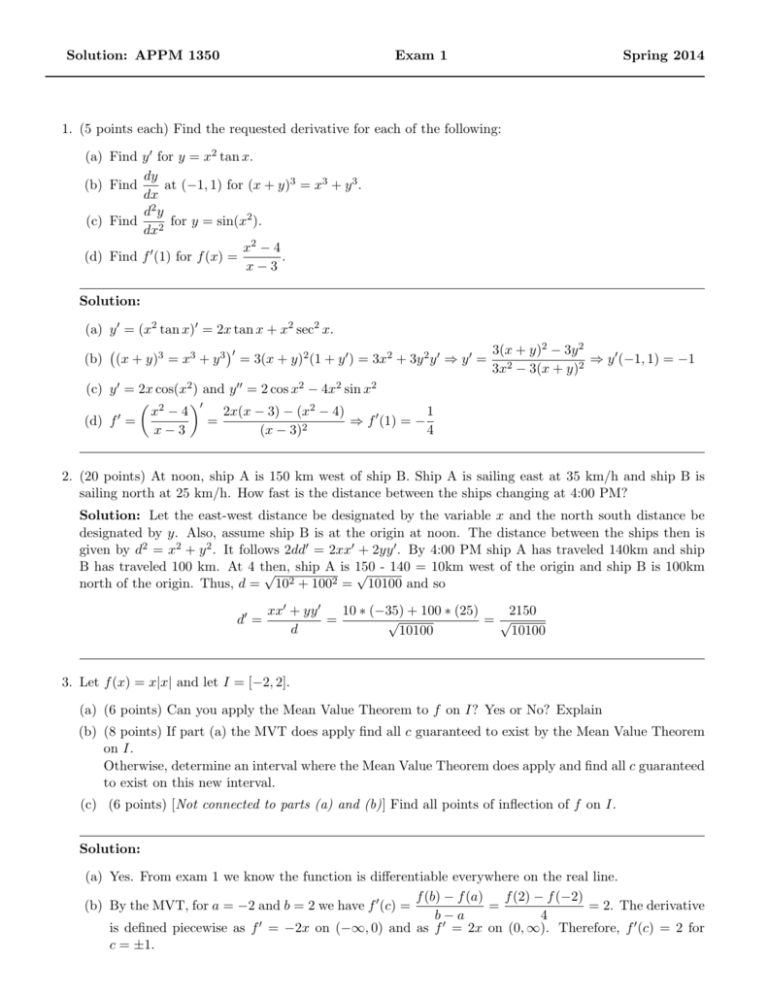
Solution: APPM 1350 Exam 1 Spring 2014 1. (5 points each) Find the requested derivative for each of the following: (a) Find y 0 for y = x2 tan x. dy at (−1, 1) for (x + y)3 = x3 + y 3 . (b) Find dx d2 y for y = sin(x2 ). (c) Find dx2 x2 − 4 (d) Find f 0 (1) for f (x) = . x−3 Solution: (a) y 0 = (x2 tan x)0 = 2x tan x + x2 sec2 x. 0 3(x + y)2 − 3y 2 ⇒ y 0 (−1, 1) = −1 (b) (x + y)3 = x3 + y 3 = 3(x + y)2 (1 + y 0 ) = 3x2 + 3y 2 y 0 ⇒ y 0 = 2 3x − 3(x + y)2 (c) y 0 = 2x cos(x2 ) and y 00 = 2 cos x2 − 4x2 sin x2 2 0 x −4 2x(x − 3) − (x2 − 4) 1 0 (d) f = = ⇒ f 0 (1) = − 2 x−3 (x − 3) 4 2. (20 points) At noon, ship A is 150 km west of ship B. Ship A is sailing east at 35 km/h and ship B is sailing north at 25 km/h. How fast is the distance between the ships changing at 4:00 PM? Solution: Let the east-west distance be designated by the variable x and the north south distance be designated by y. Also, assume ship B is at the origin at noon. The distance between the ships then is given by d2 = x2 + y 2 . It follows 2dd0 = 2xx0 + 2yy 0 . By 4:00 PM ship A has traveled 140km and ship B has traveled 100 km. At 4 then, √ ship A is 150 √ - 140 = 10km west of the origin and ship B is 100km 2 2 north of the origin. Thus, d = 10 + 100 = 10100 and so d0 = xx0 + yy 0 2150 10 ∗ (−35) + 100 ∗ (25) √ =√ = d 10100 10100 3. Let f (x) = x|x| and let I = [−2, 2]. (a) (6 points) Can you apply the Mean Value Theorem to f on I? Yes or No? Explain (b) (8 points) If part (a) the MVT does apply find all c guaranteed to exist by the Mean Value Theorem on I. Otherwise, determine an interval where the Mean Value Theorem does apply and find all c guaranteed to exist on this new interval. (c) (6 points) [Not connected to parts (a) and (b)] Find all points of inflection of f on I. Solution: (a) Yes. From exam 1 we know the function is differentiable everywhere on the real line. f (b) − f (a) f (2) − f (−2) (b) By the MVT, for a = −2 and b = 2 we have f 0 (c) = = = 2. The derivative b−a 4 0 0 is defined piecewise as f = −2x on (−∞, 0) and as f = 2x on (0, ∞). Therefore, f 0 (c) = 2 for c = ±1. (c) The only point of inflection is at x = 0 since the function is concave down on (−∞, 0) and concave up on (0, ∞). This is becasue f 00 = −2 on (−∞, 0) and f 00 = 2 on (0, ∞). 4. Suppose that we do not have a formula for g(x) but we know g(2) = −4 and g 0 (x) = p x2 + 5 for all x (a) (10 points) Use a linear approximation to estimate g(1.95). (b) (5 points) Is the estimate in part (a) too large or too small. Explain. Solution: √ (a) L(x) = g(a) + g 0 (a)(x − a) = g(2) + g 0 (2)(x − 2) = −4 + 9(x − 2) = −4 + 3(x − 2). Therefore, 15 77 g(1.95) ≈ L(1.95) = −4 + 3(0.05) = −4 + 100 = − 385 100 = − 20 . x , which is positive for positive x, the function is concave up on (0, ∞). It must (b) Since g 00 = √ 2 x +5 be the case then that the tangent line lay under the graph and so this estimate is too small. 5. (5 pts each) In answering the following questions, justify each part. Given f (x) = 2 2 2 x2 − 4 0 (x) = (x + 4)2x − (x − 4)2x and f 00 (x) = 16(4 − 3x ) , with f x2 + 4 (x2 + 4)2 (x2 + 4)3 for f (x): (a) Find the vertical and horizontal asymptotes. (b) Find the intervals of increase or decrease. (c) Find the local maximum and minimum values. (d) Find the intervals of concavity and the inflection points. (e) Use parts (a) - (d) to the sketch the graph of f . LABEL your sketch (Intercepts, asymptotes, etc.). Solution: (a) No VA and x = 1 is the HA since lim f (x) = 1 x→±∞ (x2 (x2 + 4)2x − − 4)2x 16x = 2 and so the function is decreasing on (−∞, 0) (x2 + 4)2 (x + 4)2 and increasing on (0, ∞). (b) Note that f 0 (x) = (c) The only critical point is at x = 0 and it is a minimum by the 1st derivative test. √ 2 = 0 or for x = ±2/ 3. Taking test values in the three regions (d) The inflection √ points√are when √ 4 − 3x √ √ (−∞, −2/ 3), (−2/ 3, 2/ 3) and (2/ 3, ∞) we find the function is concave down on (−∞, −2/ 3) √ √ √ and (2/ 3, ∞) and concave up on (−2/ 3, 2/ 3) f (x) = x2 − 4 x2 + 4 1 0.5 0 −0.5 −1 −10 (e) −5 0 x 5 10

